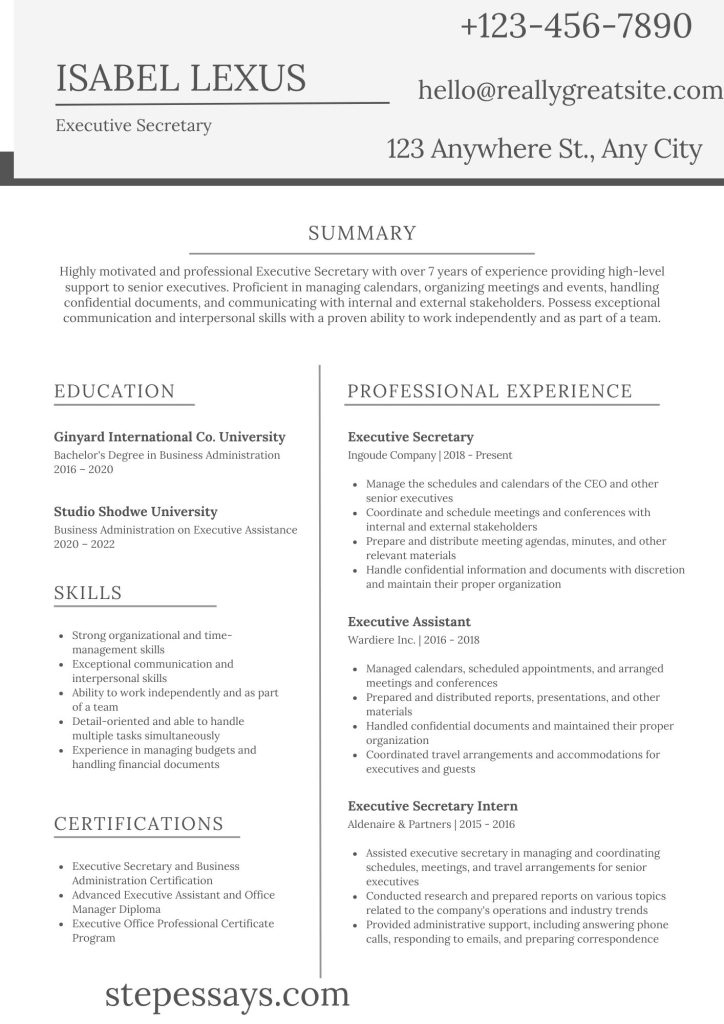Introduction
1. Choose the Right Format:
When selecting the appropriate format for your resume, you have several options to consider. The chronological format arranges your work experience in reverse chronological order, spotlighting your most recent employment first. Conversely, the functional format emphasizes your skills and accomplishments over the sequence of your work history. Lastly, the combination or hybrid format blends aspects of both chronological and functional layouts, offering a comprehensive view of your professional background while highlighting your key abilities. Each format serves its unique purpose, allowing you to tailor your resume to best showcase your qualifications and make a strong impression on potential employers.
2. Contact Information:
3. Resume Summary or Objective:
4. Professional Experience:
5. Education
6. Skills:
7. Certifications and Training:
In the “Certifications and Training” section of your resume, feature any pertinent certifications, licenses, or professional development courses you’ve successfully completed. Include the name of the certification or course, the issuing organization or institution, and the date of completion. These credentials demonstrate your commitment to ongoing learning and professional growth, underscoring your expertise and qualifications in specific areas relevant to the job you’re pursuing. By showcasing your certifications and training, you provide recruiters with tangible evidence of your skill set and dedication to staying current in your field, thereby enhancing your overall candidacy for the position.
8. Awards and Achievements:
In the “Awards and Achievements” section of your resume, highlight any notable accolades, honors, or recognition you’ve received in recognition of your work or academic accomplishments. Include the name of the award or honor, the issuing organization or institution, and the date it was received. These acknowledgments serve as tangible evidence of your excellence and dedication in your professional or academic endeavors, further validating your qualifications and expertise to potential employers. By showcasing your awards and achievements, you distinguish yourself as a standout candidate and reinforce your value proposition, ultimately strengthening your candidacy for the desired position.
9. Keywords and ATS Optimization:
To optimize your resume for Applicant Tracking Systems (ATS), incorporate relevant keywords from the job description to increase the likelihood of passing through these automated systems. Tailor your resume to include specific terms and phrases that directly relate to the job requirements and responsibilities outlined in the job posting. Avoid using overly generic terms and industry jargon that may not align with the specific criteria sought by the employer. By strategically incorporating targeted keywords, you enhance the visibility of your resume to ATS algorithms, ensuring that your qualifications and experiences are effectively matched to the job opening and maximizing your chances of progressing to the next stage of the hiring process.
10. Formatting and Design:
- Keep the design clean, professional, and easy to read.
- Use a legible font (e.g., Arial, Calibri, Times New Roman) and appropriate font size (10-12 points for body text).
- Use bullet points to list achievements and responsibilities for better readability.
- Ensure consistent formatting throughout the document.
11. Proofreading:
- Review your resume carefully for spelling and grammar errors.
- Consider asking a friend or mentor to review it as well for feedback.
12. Optional Sections:
- Depending on your background and the job you’re applying for, you may include additional sections such as:
- Volunteer Work
- Publications
- Professional Affiliations
- Language Proficiency
- Interests and Hobbies
By following these steps and customizing your resume for each application, you can increase your chances of landing interviews and ultimately, your dream job.
Example of a Resume

sample
Frequently Asked Question
What is a Resume
A resume is a document used by individuals to present their background, skills, education, and work experience to potential employers. It typically includes a summary of the person’s professional history, including previous jobs, accomplishments, and relevant skills. A well-crafted resume is essential for job seekers as it serves as a marketing tool to highlight their qualifications and suitability for a particular job or position. Resumes are usually tailored to specific job applications and are often accompanied by a cover letter, which provides additional context and explanation for why the applicant is a good fit for the role.
What is the purpose of a Resume
The purpose of a resume is to effectively communicate your qualifications, experiences, and skills to potential employers in order to secure employment opportunities. It serves as a snapshot of your professional background and achievements, providing recruiters with essential information to evaluate your suitability for a particular job. A well-crafted resume not only outlines your work history and educational credentials but also highlights your unique strengths and accomplishments that set you apart from other candidates.
Additionally, a resume serves as a marketing tool, allowing you to strategically position yourself as the ideal candidate for the desired role. Ultimately, the purpose of a resume is to showcase your value proposition and persuade employers to invite you for an interview, where you can further demonstrate your suitability for the position and contribute to the organization’s success.
